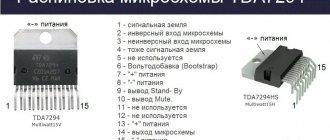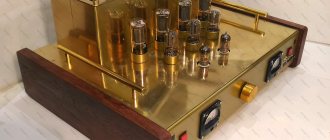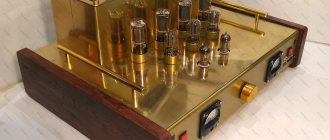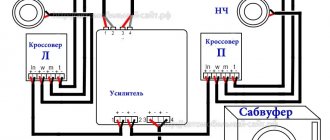After the interview, the largest number of questions related to the resistance characteristics of the headphones.
Let's consider what the characteristic affects and what it is eaten with. To better assimilate the material, we will consistently release materials, collect questions and comments, and move on. Before we figure out what and how the resistance of the headphones affects, let’s figure out what kind of overseas bird this is. And we are preparing for the fact that there will be as many as two formulas from a standard school physics course. Those. the material is complex and heavy. Resistance
A headphone is often referred to as
the impedance
or
impedance of a headphone
.
From the point of view of terms, where resistance means only the active (resistive) part, impedance (impedance) means the combination of active and reactive resistance. Remembering the school physics course, we know that reactance includes capacitance and inductance.
The final impedance of the headphones depends on the frequency at which the impedance is measured. On boxes, only the active resistance or occasionally the value obtained at a frequency of 1 kHz is often given. Unfortunately, the accompanying parameters are rarely indicated and one can only guess what the actual impedance value of the headphones is.
If we are talking about dynamic headphones, then the values are in the form of 16, 24, 32 Ohms, etc. mean only the resistance of the speaker inductor and do not take into account the resistance of the wire, soldered contacts and plug. In reality, headphone impedance is usually 1-3 ohms higher and varies slightly between the right and left channels. The most conscientious manufacturers honestly indicate that the accuracy of the indicated resistance is 20 or 30% and this is normal (only the marketer vigorously objects to this; no errors can be shown on the box - “truth” kills sales).
What type of impedance do different headphones have?
In-ear headphones
Most in-ear dynamic headphones
have a flat impedance curve and values of 16, 24 or 32 ohms have no deviations for frequencies from 20 to 20 kHz.
The graph shows frequencies horizontally, from 20 Hz to 20 kHz. Vertical – resistance (on a logarithmic scale).
Over-ear dynamic headphones
For full-size dynamic headphones
It is quite common to find an uneven impedance curve, with local rises in the low-frequency region and a slight rise in the high-frequency region.
The resistance can be equal to 32 Ohms without taking into account the reactive part (conventionally, this is 0 Hz, measured by any universal multimeter), but in practice it can be twice as high at certain frequencies.
Unevenness (rises) can indicate both resonances and design features of the emitter in a given headphone housing. So, when measuring resistance, the frequency and magnitude of the rise can vary greatly depending on whether the headphones are lying freely on the table or are put on a mannequin (in this case, the internal space of the headphones is damped).
Some dynamic headphones have no noticeable resonances or deviations. This line is conventionally ideal, but selecting headphones this way is not recommended. In pursuit of improving one characteristic, you have to sacrifice another. Among top-class headphones you can find impedance curves with both minimal deviations and significant ones. If the headphones show a narrow-band boost (in the graph above this is the Grado GS1000), then the amplifier should be selected with a low output impedance for better control of low frequencies (as, by the way, was done with the proprietary Grado RA1 amplifier).
Isodynamic (orthodynamic) headphones
the isodynamic type of emitter is now becoming widespread
(and its similar type - orthodynamic). These headphones always have a straight impedance line. Isodynamic headphones are now produced by: Abyss, Audez'e, HiFiMan, Oppo, Fostex. In Soviet times there were TDS-5/m, TDS-7, TDS-15, TDS-16 and TDS-25 headphones. Today, modding is most often done for the TDS-7 and TDS-15 models.
Formally, this is an ideal load for an amplifier, however, in the ultra-high frequency range (megahertz and gigahertz), the resistance of some models decreases and approaches zero. Such insidiousness cannot be seen on a standard chart, and with some amplifiers this can lead to poor-quality operation.
In-ear reinforcement headphones
in-ear headphones with an armature driver looks hardly predictable
. Single-driver models have a common feature - there is always a local rise in the upper midrange (around 1-3 kHz) and in the highest frequencies. Thanks to the high-frequency boost, most single-driver armature models “sound clean” in the high-frequency region, because in this frequency range the amplifier produces less distortion.
In the low-frequency region, the typical resistance is 8, 16, 24 or 32 ohms. Above 500 Hz rises begin. If a resistance of 100 Ohms at 1 kHz is indicated, this does not mean that the headphones are high-impedance; their resistance may be only 16 Ohms according to the readings of the multimeter (in the low frequency region).
Hybrid and multi-driver headphones
It is impossible to predict the impedance curve for multi-driver
and
hybrid in-ear headphones
. The impedance curve can be anything above 500 Hz. The resistance drop can easily reach 4 ohms with the stated 100 ohms at 1 kHz.
General conclusions
- The resistance in reality will be the same as on the box
if the headphones are:
In-channel dynamic
or
isodynamic - The resistance in reality will be like on the box and have unknown rises
if the headphones are:
Dynamic on-ear
and
full-size - The resistance in reality will NOT be the same as on the box
if the headphones are
armature
or
hybrid
Why actually know all this?
Sometimes manufacturers of amplifiers and players indicate what headphone impedance will be compatible and it is useful to rely on this information. If you need to find out the real resistance of armature or hybrid headphones, you can try searching for measurement results on the Internet. Methods for measuring impedance usually give a single result and do not depend on the software with the stand or the measuring complex.
Features of connecting sound speakers
Connecting several speaker systems to a signal source is carried out in a serial, parallel and parallel-serial manner. Accordingly, the speaker group parameter is calculated using Ohm's Law. The labels and operating instructions for speakers and headphones indicate their resistance (4, 8, 16 ohms). If your speakers are not new, the instruction manual is lost, or for some other reason the resistance of the speakers is unknown to you, you can measure it with a multimeter. What it is? This is a special device for measuring this parameter.
Having freed the speakers in the speakers from the equipment, measure their resistance. The multimeter will show slightly lower resistance values close to the standard ones.
Subscribe to our Social networks
What does headphone impedance affect?
Headphone sensitivity
The sensitivity of headphones is usually reduced to power, which takes into account two characteristics at once: the voltage and current supplied to the headphones.
This is a convenient final characteristic for theorists and extremely confusing for practical application by end users. For the average consumer, it is logical to think of “sensitivity = volume.” This works with speakers, because... the value is always indicated by the speaker resistance in the form of 4 or 8 ohms, and the power of the amplifier is indicated similarly. It's hard to get confused. But if for speakers there are only two standard resistances of 4 and 8 ohms and each amplifier has power for two types of resistance, then headphones have about 11 resistances: 8,16,24,32,64,128,256,320, 608, etc.
As a result, the consumer picks up headphones with different impedances and naively believes that he can compare something in terms of sensitivity.
For the sensitivity = loudness relationship to apply to headphones, sensitivity must be expressed in terms of voltage rather than power (as Sennheiser does). But most manufacturers do not indicate at all
, in what units the sensitivity is given.
This is why “everyone knows” that high-impedance headphones are quiet, and low-impedance headphones are loud. And they naively believe that for high-impedance headphones you need a “powerful amplifier”, and for low-impedance headphones a crummy smartphone is enough. And although in reality everything is completely different, due to extremely unfortunate terms from the GOST and AES standards, separate “concepts” were formed that contradict the laws of physics, but in common language quite accurately describe the result, like: “High-impedance headphones need a powerful amplifier.” Physically illiterate, but “everything is clear to everyone.”
Let's touch on this topic deeper (be careful, we're moving on to formulas from school, we're starting to strain our brains!)
At the output of the amplifier, we do not directly regulate the power at all, but only the voltage level. Depending on the resistance of the headphones, the level of current consumed by the headphones is determined, which in turn determines the resulting power level.
This is very important to understand, because... Without changing the voltage level at the output of the amplifier, we physically cannot separately increase the current level and thereby increase the power level.
U=I*R
, where U is the voltage at the amplifier output, V I is the current, A R is the headphone resistance, Ohm
W=I*U
, where W is the power at the amplifier output, W U is the voltage at the amplifier output, V I is the current, A
If your brain doesn’t boil over from two simple formulas, you can move on.
An excellent example is the Beyerdynamic DT 770 series headphones with different impedances, 32, 80, 250 and 600 Ohms (some models are discontinued).
All headphones have a single sensitivity of 96 dB/mW, which means that if we apply exactly 1 mW to the headphones, the sound pressure level will be 96 dB SPL.
At 1 mW, for different models we need to supply different voltage and current ratios:
| Resistance, Ohm | 32 | 80 | 250 | 600 |
| Voltage at 1 mW, mV | 179 | 283 | 500 | 775 |
| Current at 1 mW, mA | 5,6 | 3,5 | 2 | 1,3 |
Those.
32 ohm
model lowest voltage but the highest current level
.
High resistance model
on the contrary, you need the
highest voltage, but the lowest current level
.
Let's return to the fact that we set the voltage level at the output of the amplifier. For smartphones this is about 200-300 mV. The volume limit for high-impedance headphones is physically visible, which makes high-impedance headphones automatically “quiet”. And what we really lack is not the “power” of the amplifier, but simply voltage.
But if all manufacturers indicated voltage sensitivity, then everything would be very clear:
| Resistance, Ohm | 32 | 80 | 250 | 600 |
| Sensitivity, dB/mW | 96 | 96 | 96 | 96 |
| Sensitivity, dB/V | 111 | 107 | 102 | 98 |
As can be seen from the table, the difference in volume between models with a sensitivity of 96 dB/mW for 32 and 600 Ohms is 13 dB. Based on the voltage sensitivity data, we see a direct relationship with loudness.
Main conclusions
- Sensitivity should be looked at not to power, but to voltage. This is the only way to compare headphones by “volume”
- The lower the impedance, the higher the sensitivity of the headphones. The higher the resistance, the correspondingly lower the sensitivity.
And now that we see that different levels of voltage and current are required from the amplifier at different impedances, we can move on to other dependencies that are affected by headphone impedance.
Operating time of the player or smartphone
The higher the resistance of the headphones, the longer the player or smartphone will work without recharging, because high-impedance headphones consume less current (provided that the headphones are listened to at “maximum”, regardless of the resulting actual volume).
If you have a quiet smartphone, then there is no real choice in headphones with different impedances; only low-impedance headphones will have sufficient sensitivity.
However, if your smartphone or player has a “powerful” output (that is, providing a voltage level above 200-300 mV), then you can choose between highly sensitive low-impedance headphones and less sensitive ones with a higher impedance. In this case, with equal output volume, replacing 16 Ohms with 32 Ohms will reduce current consumption by one third. Given the energy consumption of the processor and other microcircuits, a smartphone or player may, of course, work not one third longer, but a quarter or a fifth longer. For example, with the Colorfly C4 Pro player, the operating time varies from 5 to 8 hours (5 hours with M-Audio IE40 with a strong drop in the high frequencies and 8 hours with high-impedance headphones).
For “powerful” players, such as iHiFi or Hidisz, you should select headphones with high impedance, and check the adequacy of the volume level in the store “without leaving the checkout.” In Soundpal stores you can listen and try everything before you buy.
Returning to the charts with resistance examples:
- Single-driver armature headphones actually have a higher average impedance and with them a smartphone or player can work longer without recharging.
- Multi-driver headphones may, on the contrary, have a lower average resistance and with them a smartphone or player can work for less time without recharging.
Sound quality
“Everyone knows” that “high-impedance headphones sound better.” But in this case, it is not the headphones that sound better, but the amplifier that delivers less current and, as a result, less distortion from the amplifier. But this rule is not a dogma; if the amplifier operates at a voltage level exceeding its normal operating mode, then the source of distortion will be an overload not in current, but in voltage.
This is the big secret of the quality of single-driver armature headphones
(such as Grado GR8 and GR10, Etymotic models, older Klipsh), where, thanks to the rise in the upper mid and high frequencies, high-quality sound is obtained with those players and phones where low-impedance headphones are absolutely terrible dynamic headphones.
Frequency response of headphones
If the amplifier does not have zero resistance, then the resulting frequency response will vary depending on the impedance curve of both the headphones and the amplifier. We will consider this in detail in one of the following issues, especially since this requires considering what the total output resistance (impedance) of the amplifier affects.
Low or high impedance headphones?
It's difficult to give a definitive answer to this question - a lot depends on your individual preferences and how you use the equipment. If you frequently listen to music or podcasts through portable MP3 players, lower impedance settings will be beneficial. Your favorite artists' songs will sound loud and clear, and your device won't consume too much power.
On the other hand, if sound quality is more important than volume, choose a higher impedance. These headphones will produce more detailed tones—you'll be able to hear every keystroke or guitar string. Remember, however, that this type of solution usually requires additional investment. We are talking about special amplifiers.
The standard impedance for in-ear and in-ear headphones is from 16 to 32 ohms, for over-ear and over-ear models - from 32 to 64 ohms.
How to measure headphone impedance?
To obtain a detailed schedule, you need specialized software and a stand. But to find out the value of active resistance (in the region of the lowest frequencies), a budget multimeter, costing from 200 rubles, is enough.
It is quite normal when buying headphones to check the impedance of the right and left channels; the discrepancy should not exceed 2-3 ohms between channels in most cases.
Author Kuznetsov Roman romanrex
Which headphone design should you choose?
The design of the headphones is also extremely important. You will find open-back, closed-back, and semi-open-back headphones in the market. The former provide good air circulation and free flow of sounds, but at the same time dampen less sounds coming from the environment. The user will hear external noises, and people nearby will hear the sounds produced by the headphones. This type of headphone is suitable for home use, where the amount of possible distracting noise is very limited.
Closed-back headphones have a durable, sealed housing, uniform and smooth shells without any holes. They guarantee good insulation from the noise and bustle of the environment. Music lovers will be able to listen to their favorite music without any problems, even in noisy and unfavorable environments (for example, on a tram, bus or on the street). However, this freedom of action is achieved at the cost of limited ventilation - as a result, the ears are susceptible to irritation and discomfort with prolonged use. These headphones are very often used by professional recording studios.
Semi-open headphones combine the advantages of the two previously described models. This is quite a compromise solution. They allow air to circulate and at the same time significantly reduce the amount of sound reaching the user's ear. They eliminate the effect of reflection of acoustic waves in the membrane thanks to holes located on the outside of the housing.











